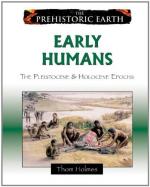|
This section contains 408 words (approx. 2 pages at 300 words per page) |
Earth is currently in the Holocene Epoch. In geologic time, the Holocene Epoch represents the second epoch in the current Quaternary Period (also termed the Anthropogene Period) of the current Cenozoic Era of the ongoing Phanerozoic Eon. The Holocene Epoch ranges from approximately 10,000 years ago until present day.
Also termed the Recent Epoch, the Holocene Epoch is thus far notable for the retreat of glaciers—a major force in producing the landscape topographical features evident today—and the geological time during which humans (Homo sapiens) became the dominant life form on Earth, increased their societal relationships, and produced major civilizations. The retreat of glaciers and the gradual climactic warming in the Northern Hemisphere encouraged migration and biological radiation of species.
Although Homo sapiens appeared during the preceding Pleistocene Epoch, and were fully differentiated as a species by the beginning of the Holocene Epoch, human societal evolution has taken place during the Holocene Epoch. As expected, the most recent and superficial of sedimentary remains were laid down during the Holocene Epoch. The fossil record is also dotted with an archaeological record of human activity and civilization.
Human societal and intellectual development during the Holocene Epoch produced the first species capable of significantly and consciously altering geophysical processes. In addition to deliberate reworking of topographical features and use of natural resources, byproducts of human civilization and industrialization have affected groundwater reservoirs, the type of abundance of weathering agents, the geochemistry of atmospheric processes on a local scale (e.g., acid rain); and possible atmospheric and/or marine processes on a global scale (e.g., possible global warming).
The general retreat of glaciation was punctuated by smaller-scale "ice ages"—including the "Little Ice Age" that occurred between approximately 1150 and 1700. One of the reasons that it is difficult for modern scientists to quantify the possible extent in global warming is that accurate climatic data extends back, at best, only about a hundred years. Accordingly, it is difficult to determine whether any data indicating global warming is simply a normal variation in a general downtrend, or a normal variation in generalized warming pattern.
See Also
Archean; Cambrian Period; Cretaceous Period; Dating Methods; Devonian Period; Eocene Epoch; Evolution, Evidence Of; Fossil Record; Fossils and Fossilization; Geologic Time; Historical Geology; Holocene Epoch; Jurassic Period; Mesozoic Era; Miocene Epoch; Mississippian Period; Oligocene Epoch; Ordovician Period; Paleocene Epoch; Paleozoic Era; Pennsylvanian Period; Pliocene Epoch; Precambrian; Proterozoic Era; Silurian Period; Supercontinents; Tertiary Period; Triassic Period
|
This section contains 408 words (approx. 2 pages at 300 words per page) |


